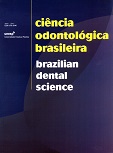Estudo in vitro da infiltração marginal apical em canais obturados pela técnica termomecânica híbrida
DOI:
https://doi.org/10.14295/bds.2005.v8i1.232Abstract
O objetivo do presente estudo consistiu em avaliar in vitro a infiltração marginal apical em canais obturados com os cimentos Endofill®, Ketac Endo® e Sealer26® pela técnica termomecânica híbrida. Neste experimento foram utilizados 32 caninos superiores de estoque, sendo dois dentes utilizados para os grupos controle positivo e negativo. Durante a instrumentação dos canais radiculares, os dentes receberam 02mL de água destilada a cada troca de instrumento. Terminada essa fase, os dentes foram divididos, aleatoriamente em 3 grupos, e preparados para obturação dos canais radiculares pela técnica termomecânica híbrida. Os dentes foram imersos em tinta Nanquim e submetidos ao processo de descalcificação e clareamento para a visualização do nível de infiltração marginal apical. A penetração do Nanquim na região apical foi medida por meio do microscópio de mensuração. Os dados foram submetidos à análise estatística paramétrica, que evidenciou haver diferença significante a nível de 1% entre os cimentos testados. Concluiu-se que nenhum dos cimentos utilizados foi capaz de impedir a infiltração marginal apical e a ordenação crescente dos níveis de infiltração marginal é a seguinte: Sealer26®, Endofill® e Ketac-Endo®.Downloads
Downloads
Published
How to Cite
Issue
Section
License
Brazilian Dental Science uses the Creative Commons (CC-BY 4.0) license, thus preserving the integrity of articles in an open access environment. The journal allows the author to retain publishing rights without restrictions.
=================




























